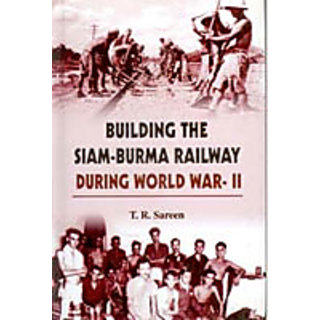
Building The Siam Burma Railway During World War-Ii
Quick Overview
Rs. on ShopcluesBuy
Product Price Comparison
Description:- , About The Author:- Dr. T.R. Sareen, retired as Director, Indian Council of Historical Research, was formerly Assistant Director National Archives of India, was a Records Management Consultant with the Government of Kenya. Having traveled widely in India and abroad, Dr. Sareen has many published works to his credit, apart from a number of articles on Indian history and culture. His publications include Indian Revolutionary Movement Abroad 1905-1929, Russian Revolution and the Indian National Movement, Subhas Chandra and Nazi Germany, Singapore Mutiny, Subhas Chandra and the Japanese Occupation of Andamans, 1942-45, and British Intervention in Transcaspian 1917-19. At present, he is working on the project, Japanese Prisoners of War in India, 1942-46., Contents:- Contents #Introduction : Documents : Report on Siam-Burma Railway By Lieut C.C. Bert : History of ?F? Force : Report of Conditions During Expedition of 3270 Prisoners of War Designated as ?H? Force as a labor organization into Thailand-Singapore during the period May-December 1943 : Condition of Prisoners of War in Japanese Hands-An Account by Captain J. Gibson, R.A. : Statement by Major F.J.H. Nelson R.A. B.M.R.A. 9th Indian Div. on Conditions in the P.O.W.Camp Under Japanese Control : Report by Capt. J.W. Chapmen 1st Gurkh Rifles Regarding the Organisation etc. of Prisoners in the Taka-nun Camp, Thailand., About The Book:- No Subject Created So Much Controversy During And After The Pacific War As The Japanese Treatment Of The Allied Prisoners Of War (P.O.W.) In Flagrant Violation Of The Geneva Convention. Whether It Was Due To The Racial War Carried Out By The Japanese Or Was The Outcome Of The Mistaken Value Of ?Bushido? The Question Has Never Been Resolved. The Harsh And Brutal Treatment Of The P.O.W. Was Fully Demonstrated, When The Japanese Decided To Utilize Them For The Construction Of Siam-Burma Railway. Driven Like Slaves And With Semi-Starvation Diet, The Allied P.O.W. Were Left With No Stamina To Fight Tropical Diseases. As A Result Thousands Of Them Died While Working On Siam-Burma Railway, Which Came To Be Known As ?Railroad Of Death?. A Fuctional Account Of The Sufferings Of The Allied P.O.W. Was Made Famous By Hollywood Few Years Back In The Film The Bridge On The River Kwai. In This Book The Author Has Reproduced The Original Reports To Presents The Factual Details. It Is Hoped That These Reports Will Be Usefull For The Students Studying The Japanese Policy During The Second World War., About The Author:- Dr. T.R. Sareen, Retired As Director, Indian Council Of Historical Research, Was Formerly Assistant Director National Archives Of India, Was A Records Management Consultant With The Government Of Kenya. Having Traveled Widely In India And Abroad, Dr. Sareen Has Many Published Works To His Credit, Apart From A Number Of Articles On Indian History And Culture. His Publications Include Indian Revolutionary Movement Abroad 1905-1929, Russian Revolution And The Indian National Movement, Subhas Chandra And Nazi Germany, Singapore Mutiny, Subhas Chandra And The Japanese Occupation Of Andamans, 1942-45, And British Intervention In Transcaspian 1917-19. At Present, He Is Working On The Project, Japanese Prisoners Of War In India, 1942-46., Content:- Introduction : Documents : Report On Siam-Burma Railway By Lieut C.C. Bert : History Of ?F? Force : Report Of Conditions During Expedition Of 3270 Prisoners Of War Designated As ?H? Force As A Labor Organization Into Thailand-Singapore During The Period May-December 1943 : Condition Of Prisoners Of War In Japanese Hands-An Account By Captain J. Gibson, R.A. : Statement By Major F.J.H. Nelson R.A. B.M.R.A. 9Th Indian Div. On Conditions In The P.O.W.Camp Under Japanese Control : Report By Capt. J.W. Chapmen 1St Gurkh Rifles Regarding The Organisation Etc. Of Prisoners In The Taka-Nun Camp, Thailand.
